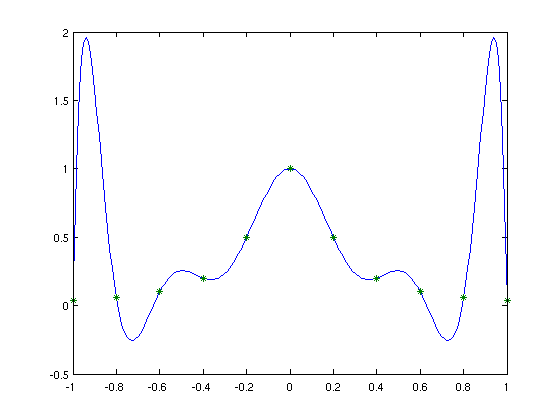% Use Newton's forward difference to interpolate % function f(x) at n+1 points. % % Pay attention that the indices in Matlab % start from 1, while it starts from 0 in the algorithm % given in class. You need to shift the indices in the program. % Set n, x_i and f(x_i) n = 10; x = [-1 -0.8 -0.6 -0.4 -0.2 0 0.2 0.4 0.6 0.8 1]; fx = [0.0385 0.0588 0.1 0.2 0.5 1 0.5 0.2 0.1 0.0588 0.0385]; % The values f(x_i) are stored in the first column of % an (n+1)*(n+1) matrix F. F = zeros(n+1, n+1); F(:, 1) = fx; % Compute the Newton divided differences. for i=1:n for j=1:i F(i+1,j+1) = (F(i+1,j)-F(i,j)) / (x(i+1)-x(i-j+1)); end end % Print out the coefficients of the interpolation, % which is given by F(1,1), F(2,2), F(3,3), ... F(n+1,n+1). % Then the Lagrange interpolation is % (here all indices have been shifted so it starts from 1 and end at n+1) % F(1,1) + F(2,2)*(x-x1) + F(3,3)*(x-x1)*(x-x2) + ... % + F(n+1,n+1)*(x-x1)*(x-x2) ... (x-xn) % We can use the Matlab command "diag" to get these diagonal elements. a = diag(F) % Next, we would like to draw the graph of the Lagrange interpolation. % To do this, we first need to evaluate the polynomial at a set of points. % The x and y coordinates of these points are stored in plotx and ploty. plotx = -1:0.01:1; % Evaluate the value of the Lagrange interpolation "Horner-style". ploty = a(n+1)*ones(size(plotx)); for i=n:(-1):1 ploty = a(i) + ploty.*(plotx-x(i)); end % Draw the graph. % The curve is the interpolation, % and the given points (x_i, f(x_i)) are shown as stars. figure(1); plot(plotx, ploty, '-', x, fx, '*');
a =
0.0385
0.1015
0.2612
0.7896
2.6901
-6.3672
-17.6714
84.8385
-167.9135
220.9403
-220.9403
